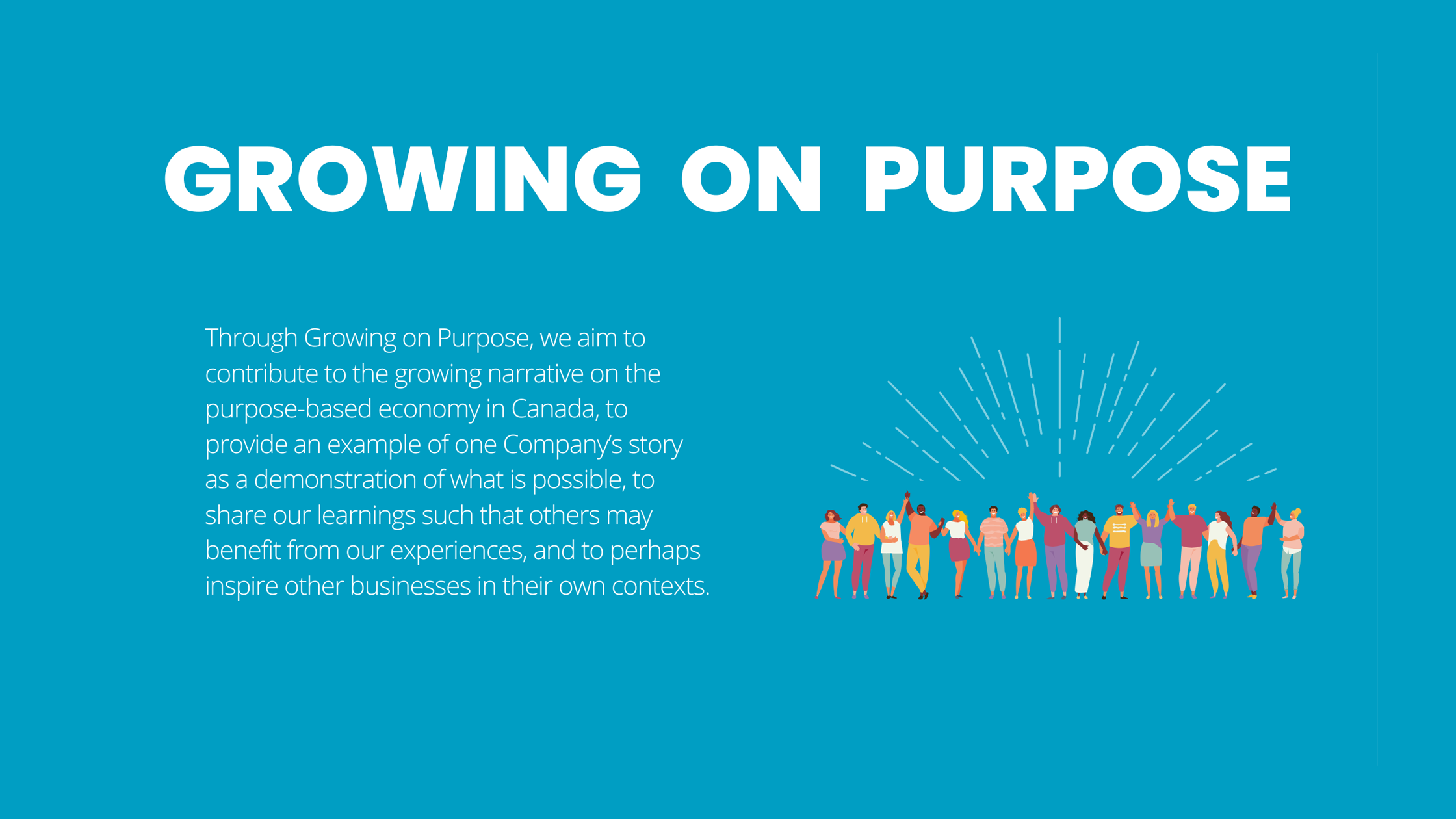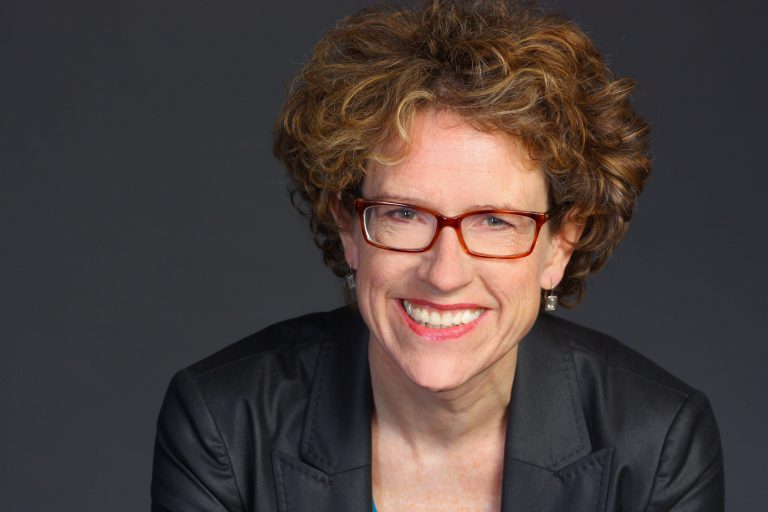
7 October 2022
Growing on Purpose – Part 2
Welcome to the second instalment in our 4-part blog series Growing on Purpose, where we explore and share the evolutionary journey we have been on in designing and launching into our socially purposed business, Urban Matters CCC.
For this second instalment, we’ve invited Coro Strandberg to ask Ken Gauthier, Urban Matter’s President/CEO, some pointed questions. Coro is the President of Strandberg Consulting and a global thought-leader in creating an enduring and sustainable marketplace in Canada, one that enhances outcomes for society as a whole and the businesses within it.

Coro: OK Ken, Allyson covered a lot of ground with you in Part 1. I would like to pick up the trail where she left off and dig a little deeper into what’s been created here, and what the team has learned from it such that other organizations might benefit from that experience.
So, your team at Urban Systems Ltd. decided to create a subsidiary entity to explore an enhanced position in social development. What exactly did you create?
Ken: We created a subsidiary company called Urban Matters CCC. For all the reasons outlined in the previous blog, we wanted to try this out in its own container, unencumbered by many of the internal systems that the parent company has developed for its own success within its own context. Since this was in an entirely new ecosystem than our parent company, it warranted a fresh look at developing what would ultimately be required to support and sustain it effectively.
Coro: Interesting. In hindsight do you think you needed to incorporate a separate subsidiary company?
Ken: It definitely needed its own container, but I think a separate incorporation isn’t always going to be essential for other organizations. Separately branded programs might do the trick in some cases. In others the effort could just look like a natural evolution to their current core business models, or a partnership with an organization already working in the field of interest. I wouldn’t advocate for one size fits all; it’s very circumstantial and unique to the cultural context of the firm.
For us, the approach definitely needed to be arms length in some capacity as the dominant paradigm of a professional engineering and planning firm did not necessarily lend itself to the set of approaches and thinking we developed for Urban Matters CCC. Also, the business model at Urban Systems Ltd. was doing just fine as it was, and while we wanted room for Urban Matters CCC to grow and find its place, we also wanted to protect and not interfere with the foundational business model at Urban Systems Ltd.
Coro: Why did you choose to use this incorporation model, the Community Contribution Company (CCC)?
Ken: Let me start off with a quick introduction to the CCC model. The B.C. Government made this incorporation model available back in 2012 — so it was brand new at the time — as a social innovation that mandated a dual bottom-line approach. It requires a fixed social purpose at the time of incorporation, reinvestment of dividends back into community, and full open disclosure of financial circumstances.
At the time it fit nicely into what we were trying to create, and most importantly, it backed social purpose and intent into the organization from inception. Within the constellation of organizations at Urban Systems Ltd., we had good experience operating on a for-profit basis, and an operating charity in place (the Urban Systems Foundation), so this hybrid incorporation model also fit in nicely in between those experiences.
Mostly we were attracted to the model as it helped push our boundaries and thinking around creating outcomes in communities in concert with our financial sustainability. It basically runs like a business, but profits get reinvested back into the community to create impact and more resilient outcomes. It sounds simple enough but it sure changes the dynamics in the boardroom.
Coro: I bet. So, what has been the learning around that? Would you use that model again or recommend it to others?
Ken: It’s been a bit of a journey with that incorporation model. It has served us well to meet the purpose of mandating the dual bottom lines of social outcomes and financial sustainability.
Other features have proven to be less useful and even cumbersome in some cases, so while it’s been a good model for getting out of the gates and embedding some baseline policy and frameworks for how we think about and do things, it is probably less useful now and going forward.
Coro: Expand on that please?
Ken: There are a few small features that are no longer holding their value for us moving forward. For example, given the public disclosure requirements of the CCC model, a more rigorous accounting review standard is applied, which creates some inconsistency issues internally across the spectrum of companies and costs two to three times more to undertake.
At the time that we made the choice to use the model, the B.C. Government was considering preferential tax circumstances to support the CCC model, which never materialized. Despite reinvesting (or donating in some cases) a large portion of our profits annually, we are taxed as a standard for-profit business. As successive provincial governments have come and gone since the model was made available, there has been very little interest in promoting it to any extent, rendering it still relatively invisible and unrecognized. These aren’t deal-breakers for us, but they certainly create good questions for us to consider.
Would we recommend it to others? Again, context is king. Generally speaking, it could make sense as a standalone start up social enterprise, or as a social enterprise attached to a charity or a not-for-profit society.
Coro: How is governance handled across the internal organizations? Are the Boards independent of each other, or overlapping?
Ken: They are independent at the moment, with the Directors all sourced internally. That is as much about capacity as anything. Ideally, we’d like to work toward some overlapping circumstances and some external perspectives to enhance the learning and cross-pollination. More to come on that front.
Coro: You mentioned hard-wiring social purpose into the organization. How were you collectively able to achieve that, and how is that being measured?
Ken: Good question—that’s really the key to all this isn’t it? There are many features of the CCC model that hard wire social purpose into the organization, which is what made it so attractive at the outset. A fixed social purpose as an organization at incorporation and throughout its existence, mandated profit/dividend reinvestment back into community, public disclosure on progress towards that purpose, mandatory divestment of the organizations’ asset upon dissolution. These are all embedded in the incorporation model, and, as you can see, are really designed specifically for this purpose.
Having said all that, this model doesn’t really govern what an organization actually does. So even with these fairly rigid regulations, we needed to further embed social purpose into what we do everyday, what activities we undertake, and how we measure our progress on them.
On that front we’ve developed our business strategy around making progress on the Social Determinants of Health and have developed a measurement protocol against which all of our activities are considered, reported to our Board, and very soon to our community in our Annual Report.
Coro: Tell me about the working relationship between the subsidiary and the parent company? How is learning being transferred back and forth? Does the subsidiary incorporation create an internal barrier to collaboration?
Ken: That relationship has experienced some turbulence for sure. In the early years, we didn’t really have a great explanation or firm business plan in place to explain what we were targeting, what the parent company could expect, or how we were planning to go about achieving some success. That of course created some tension and questions.
On the flip side, I think it also created a sense of defensiveness on the Urban Matters CCC team as well as tentativeness as they felt second guessed or unsupported at times. Breaking the mold and taking a stab at innovating requires thick skin, especially in an established operating environment.
But as the results started coming in, and we were able to be more clear about both what we were attempting to achieve and the methods by which we sought to achieve them, the dialogue began to turn the corner. Acceptance and support grew; now we’re moving into a period of close and positive collaboration.
“It’s time for all hands on deck. Whether you are selling tires, leading a national scale professional services firm, or running a small community bicycle shop, there is an enhanced role that you can be playing in your community.”
– Ken Gauthier
Coro: Can you tell us about where you collectively started to find your pattern? What are you doing and how is it different from what your parent company is doing, and how is it making the world a better place? We want to unpack this example so that other companies might see something similar in this for themselves in their own contexts.
Ken: Wow, ok, big question.
We spent some time trying to figure out where the social development and social innovation sectors needed, or wanted, us positioned. We tried to enter into the space cautiously and purposefully, not aspiring to disrupt or upset and of the delicate balance of activity that already existed there. We were trying to be an asset to the system, not a competitor or a detractor.
We pivoted a number of times in the 2015-2018 years attempting to fill in the blanks for ourselves. We learned a lot about the gaps we could help to fill, and perhaps the areas to avoid too. What we ultimately learned was that we possessed a number of highly valuable attributes that could add capacity to the sector. This is really the point to make here for other companies considering something in their own contexts. Understand the sector you are attempting to benefit, and as importantly, understand your true assets relative to that sector, which may not always be what you think they are.
In our case, we learned that our highest value to the sector included less obvious attributes like:
- Independence – Being a self-funded and private actor has its benefits, particularly relative to a sector that is often biased based upon who is funding them. It effectively allows us to say what needs saying, and do what needs doing, without necessarily being beholden to the politics of funding
- Expertise – This applies not just in the academic sense but also in an experiential sense. Our team goes deep into the topics we’re working on and brings that knowledge to the table in a relatable way. Not as consultants preaching vertically, but partners who appreciate that lived and real experiences in the areas we’re working within are every bit as valuable as textbook knowledge and career experiences. We tend to hire team members who bring both sides of the experience coin to the table.
- Trust – The goodwill and trust afforded to our parent company after almost 50 years of dedicated service in Canada extends to our subsidiary as well. That has allowed us to enter into many contexts and to participate at many more tables than had we started this fresh from scratch.
- Resources – Aside from expertise, we knew that we weren’t going to enter in this sector solely with our hands extended awaiting fee-for-service engagements. While we do need to continually find ways to keep our lights on, our CCC model allows us to also bring financial resources to the table as a funder. We now possess that duality of position — both as a service provider and a funder into the sector.
Coro: OK so more detailed please, what exactly are you doing now?
Ken: With all of that experience, we have found a comfortable position for ourselves in between frontline service providers dealing with a host of prevalent social issues and the varying levels of government that are responsible for them. We’re an independent intermediary providing support at both ends of that spectrum, including funding in some cases. We’re working across the Social Determinants of Health framework as a model for the topical areas within which we engage, but right now our partners have us very actively involved in supporting efforts in affordable housing and homelessness, opioid response, poverty reduction and EDI initiatives including Reconciliation.
We help our partners understand the complexity of a certain issue within a community through various forms of assessment, analysis, and study (we map the system together). We often bring affected/interested parties together to explore their realities, usually in the form of a social innovation lab (we explore the gaps together), and then we’re positioned to support and possibly invest in and support the development of prototypes and outcomes emerging from those exercises (we invest in outcomes). The outcomes often take the form of educational campaigns, policy advocacy, social ventures, or physical projects like housing — so far anyway. The point here is sticking with the consortium and supporting them through to implementation, whatever that needs to look like. That was a big part of the gap that we hope to help to fill: the freedom and resources to support implementation.
Coro: So how did the sector receive you? What kinds of barriers did you encounter?
Ken: Similar to how I described the relationship with the parent company, at first the response was lukewarm at best. We didn’t have a firm value proposition mapped out, so of course there were some concerns expressed about what was perceived to be an attempt at a “corporate-entry” into a delicate ecosystem of largely NGO service providers funded by various levels of government.
Once we got into our groove and developed a little traction alongside some results, the opportunity for partnerships has become more obvious — particularly since we became a funder ourselves.
Coro: We’ve covered lots of ground here, but I need to get at a few more questions… what’s the real learning here for other companies? Obviously this experience has worked out well for Urban Systems Ltd., but what’s the big takeaway for other organizations?
Ken: We can’t speak for everyone else in terms of what they might take away from this. Our hope is that exposing the story and what happened behind the headlines at least serves to spark some dialogue in the leadership circles of other organizations that might be interested in something similar.
If pressed, I would really like this to serve as a demonstration that businesses can be playing a more impactful role in the communities that they serve, that there are creative ways to bridge their capacities and resources into supporting society while still maintaining themselves as a business. This doesn’t need to look just like charitable giving anymore. Our situation and circumstance in society demands more, and your employees will expect more of you. It’s time for all hands on deck. Whether you are selling tires, leading a national scale professional services firm, or running a small community bicycle shop, there is an enhanced role that you can be playing in your community.
Coro: More specifically then, how does the parent company, Urban Systems Ltd., benefit from Urban Matters CCC?
Ken: Of course. As a community development focused organization itself, Urban Systems Ltd. gains access to the deep and complex environment of social development and social innovation. This is a rich opportunity space to demonstrate its commitment to communities, to create a more active learning environment for its staff, to continually learn how to innovate and be a responsive organization, and to do so in a financially sustainable way. At a higher level, Urban Systems Ltd. is able to further demonstrate its commitment to its higher calling and purpose (Spirit in Service for Vibrant Communities) and bring new resources and opportunities to the table with its core clients.
Coro: It seems that community-centric organizations such as Urban Systems Ltd. might benefit from setting up subsidiary organizations to help achieve their purpose. You’ve established both a charity and a social enterprise to create an intentional ecosystem able to leverage each other’s assets and extend your reach and positioning you to mobilize various forms of capital to achieve your overall objectives. Do I have that right, and if so, what would you add or change?
Ken: Yes, you have that right! Urban Systems Ltd. has been at this for a while and has built up this ecosystem to help it achieve its goals more broadly. Structurally I wouldn’t change much; we’ve got our hands full in harmonizing these elements for the next few years. In time though, and at the risk of ringing some alarm bells, I think we’re going to be looking to create some sort of financial intermediary, or partner with one in a customized way, to help us accrue and magnify our financial resources from the constellation of companies. But that’s a conversation for another day.
Coro: It’s really interesting. This experience reflects mine on the board of Vancity Credit Union for 12 years where we set up a foundation, a for-purpose real estate subsidiary and a social purpose venture capital corporation. We used these vehicles to build our internal capacity, create more financial tools to advance our social purpose and attract different forms of capital. The boards acted as a director pipeline for the main board and created opportunities for the board and management directors to collaborate. We were able to pilot innovations in the subsidiaries before scaling them through the credit union. And as a regulated institution we needed to create containers for our social innovations.
What do you feel is the most ideal configuration of subsidiaries for a social purpose company? A charity, a dual purpose company, anything else? Maybe a non-profit? What would this ecosystem look like?
Ken: We’ve started working with a few companies now, outside of Urban Systems Ltd., sharing our experiences and providing some guidance and perspective on theirs, and I can honestly say that it really depends upon what you are trying to achieve and the context within which you are operating. As you just noted, VanCity’s context was and is very different from Urban Systems’ as is the ensuing configuration. Having said that, I do feel strongly that separation of some sort is essential if you are trying to innovate and break away from the dominant paradigms of a well-worn (and successful) business model. That doesn’t have to look like a subsidiary company per say, but it needs breathing room for sure.
Coro: Thanks Ken, that’s probably all we have time for this round.
Ken: Thank you Coro, for all that you do and have done.
To learn more from Coro Strandberg’s about the broader role in business in our society and its potential, visit www.corostrandberg.com. You can also learn about her work with the United Way in creating the Social Purpose Institute at www.socialpurpose.ca.




